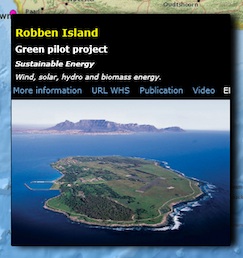A model for self-sustaining communities in South Africa.
 By using a hybrid approach to power generation, the Greening of Robben Island project will reduce the demand on the island’s infrastructures and its dependence on fossil fuels.
By using a hybrid approach to power generation, the Greening of Robben Island project will reduce the demand on the island’s infrastructures and its dependence on fossil fuels.
In 1999 Robben Island was inscribed on Unesco’s list of world heritage sites. As such it holds distinct historical meaning for South Africa and is a popular tourist destination.
Initially it served as a training and defence station during the Second World War. Later it was a place of quarantine for those suffering from leprosy, and in 1961 it became a penal colony for political prisoners. Now it is to become the model for self-sustaining communities in South Africa and the Southern African region.
The intended project was to retrofit Robben Island with renewable energy generating capacity and energy efficient equipment on Robben Island. The objectives were to illustrate the “Energy Island” concept, and have an operational test bed to show that hybrid renewable energy solutions were not only possible from an engineering perspective, but also from an economic perspective.
Due to insufficient progress on the project, the Board took a decision to divert the funding for the project to other near to implementation initiatives. The project will be revisited once there is sufficient consensus amongst stakeholders (SANEDY REPORT 2012).
Source: MediaClubSouthAfrica















